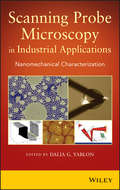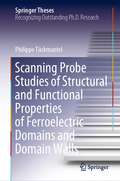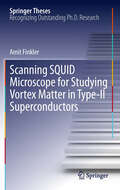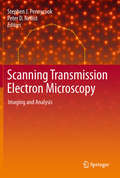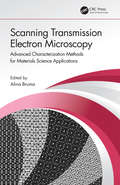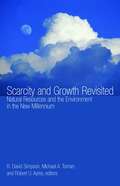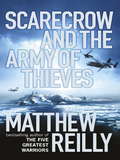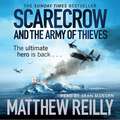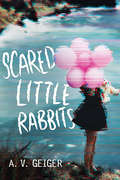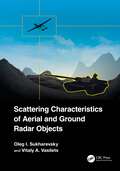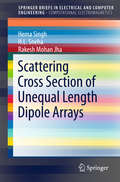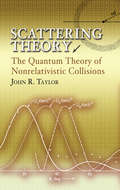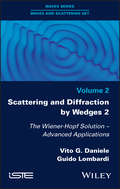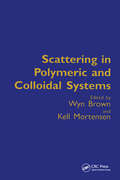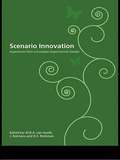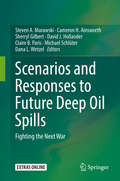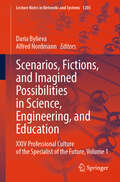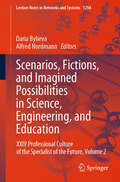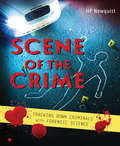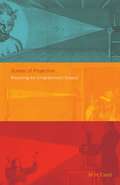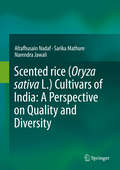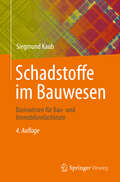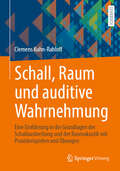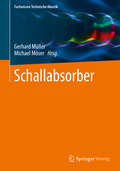- Table View
- List View
Scanning Probe Microscopy¿in Industrial Applications: Nanomechanical Characterization
by Dalia G. YablonDescribes new state-of-the-science tools and their contribution to industrial R&D With contributions from leading international experts in the field, this book explains how scanning probe microscopy is used in industry, resulting in improved product formulation, enhanced processes, better quality control and assurance, and new business opportunities. Readers will learn about the use of scanning probe microscopy to support R&D efforts in the semiconductor, chemical, personal care product, biomaterial, pharmaceutical, and food science industries, among others. Scanning Probe Microscopy in Industrial Applications emphasizes nanomechanical characterization using scanning probe microscopy. The first half of the book is dedicated to a general overview of nanomechanical characterization methods, offering a complete practical tutorial for readers who are new to the topic. Several chapters include worked examples of useful calculations such as using Hertz mechanics with and without adhesion to model a contact, step-by-step instructions for simulations to guide cantilever selection for an experiment, and data analysis procedures for dynamic contact experiments. The second half of the book describes applications of nanomechanical characterization in industry, including: New formulation development for pharmaceuticals Measurement of critical dimensions and thin dielectric films in the semiconductor industry Effect of humidity and temperature on biomaterials Characterization of polymer blends to guide product formulation in the chemicals sector Unraveling links between food structure and function in the food industry Contributions are based on the authors' thorough review of the current literature as well as their own firsthand experience applying scanning probe microscopy to solve industrial R&D problems. By explaining the fundamentals before advancing to applications, Scanning Probe Microscopy in Industrial Applications offers a complete treatise that is accessible to both novices and professionals. All readers will discover how to apply scanning probe microscopy to build and enhance their R&D efforts.
Scanning Probe Studies of Structural and Functional Properties of Ferroelectric Domains and Domain Walls (Springer Theses)
by Philippe TückmantelThis thesis explores the fascinating properties of domain walls in ferroelectric materials. Domain walls can be used as model systems to study fundamental aspects of interface physics, such as crackling noise, with implications extending to a broad variety of systems, from material fracture and earthquakes to solar flares and collective decision making. Ferroelectric domain walls also show functional properties absent from the domains themselves, such as enhanced conduction leading to the tantalizing possibility of reconfigurable nanoelectronic circuitry where domain walls are active components. This work discusses the crackling physics of domain walls in thin films of Pb(Zr0.2Ti0.8)O3, as well as links between the local conductivity of domain walls and nanoscale geometrical distortions due to defects, and discusses unusual polarization textures with rotational components at crossings of ferroelastic twin domains. The results presented in this thesis have important implications for the experimental study of crackling systems.
Scanning SQUID Microscope for Studying Vortex Matter in Type-II Superconductors
by Amit FinklerCommon methods of local magnetic imaging display either a high spatial resolution and relatively poor field sensitivity (MFM, Lorentz microscopy), or a relatively high field sensitivity but limited spatial resolution (scanning SQUID microscopy). Since the magnetic field of a nanoparticle or nanostructure decays rapidly with distance from the structure, the achievable spatial resolution is ultimately limited by the probe-sample separation. This thesis presents a novel method for fabricating the smallest superconducting quantum interference device (SQUID) that resides on the apex of a very sharp tip. The nanoSQUID-on-tip displays a characteristic size down to 100 nm and a field sensitivity of 10^-3 Gauss/Hz^(1/2). A scanning SQUID microsope was constructed by gluing the nanoSQUID-on-tip to a quartz tuning-fork. This enabled the nanoSQUID to be scanned within nanometers of the sample surface, providing simultaneous images of sample topography and the magnetic field distribution. This microscope represents a significant improvement over the existing scanning SQUID techniques and is expected to be able to image the spin of a single electron.
Scanning Technologies for Autonomous Systems
by Oleg Sergiyenko Wendy Flores-Fuentes Julio C. Rodríguez-Quiñonez Moises J. Castro-ToscanoThis book provides the theory, methodology, and uses of scanning technologies for the application of autonomous systems. The authors provide readers with an understanding of different technologies and methods to perform scanning technologies and their optimal application depending on the kind of autonomous system. Also, the book presents a compilation of original high-quality contributions and research results from worldwide authors on emerging new autonomous systems based on different scanning technologies. This book is a valuable reference for engineering professionals and the scientific community.
Scanning Transmission Electron Microscopy
by Stephen J. Pennycook Peter D. NellistScanning transmission electron microscopy has become a mainstream technique for imaging and analysis at atomic resolution and sensitivity, and the authors of this book are widely credited with bringing the field to its present popularity. Scanning Transmission Electron Microscopy(STEM): Imaging and Analysis will provide a comprehensive explanation of the theory and practice of STEM from introductory to advanced levels, covering the instrument, image formation and scattering theory, and definition and measurement of resolution for both imaging and analysis. The authors will present examples of the use of combined imaging and spectroscopy for solving materials problems in a variety of fields, including condensed matter physics, materials science, catalysis, biology, and nanoscience. Therefore this will be a comprehensive reference for those working in applied fields wishing to use the technique, for graduate students learning microscopy for the first time, and for specialists in other fields of microscopy.
Scanning Transmission Electron Microscopy: Advanced Characterization Methods for Materials Science Applications
by Alina BrumaScanning Transmission Electron Microscopy is focused on discussing the latest approaches in the recording of high-fidelity quantitative annular dark-field (ADF) data. It showcases the application of machine learning in electron microscopy and the latest advancements in image processing and data interpretation for materials notoriously difficult to analyze using scanning transmission electron microscopy (STEM). It also highlights strategies to record and interpret large electron diffraction datasets for the analysis of nanostructures. This book: Discusses existing approaches for experimental design in the recording of high-fidelity quantitative ADF data Presents the most common types of scintillator-photomultiplier ADF detectors, along with their strengths and weaknesses. Proposes strategies to minimize the introduction of errors from these detectors and avenues for dealing with residual errors Discusses the practice of reliable multiframe imaging, along with the benefits and new experimental opportunities it presents in electron dose or dose-rate management Focuses on supervised and unsupervised machine learning for electron microscopy Discusses open data formats, community-driven software, and data repositories Proposes methods to process information at both global and local scales, and discusses avenues to improve the storage, transfer, analysis, and interpretation of multidimensional datasets Provides the spectrum of possibilities to study materials at the resolution limit by means of new developments in instrumentation Recommends methods for quantitative structural characterization of sensitive nanomaterials using electron diffraction techniques and describes strategies to collect electron diffraction patterns for such materials This book helps academics, researchers, and industry professionals in materials science, chemistry, physics, and related fields to understand and apply computer-science–derived analysis methods to solve problems regarding data analysis and interpretation of materials properties.
Scarcity and Growth Revisited: Natural Resources and the Environment in the New Millenium
by Robert U. Ayres R. David Simpson Michael A. TomanIn this volume, a group of distinguished international scholars provides a fresh investigation of the most fundamental issues involved in our dependence on natural resources. In Scarcity and Growth (RFF, 1963) and Scarcity and Growth Reconsidered (RFF, 1979), researchers considered the long-term implications of resource scarcity for economic growth and human well-being. Scarcity and Growth Revisited examines these implications with 25 years of new learning and experience. It finds that concerns about resource scarcity have changed in essential ways. In contrast with the earlier preoccupation with the adequacy of fuel, mineral, and agricultural resources and the efficiency by which they are allocated, the greatest concern today is about the Earth?s limited capacity to handle the environmental consequences of resource extraction and use. Opinion among scholars is divided on the ability of technological innovation to ameliorate this 'new scarcity.' However, even the book?s more optimistic authors agree that the problems will not be successfully overcome without significant advances in the legal, financial, and other social institutions that protect the environment and support technical innovation. Scarcity and Growth Revisited incorporates expert perspectives from the physical and life sciences, as well as economics. It includes issues confronting the developing world as well as industrialized societies. The book begins with a review of the debate about scarcity and economic growth and a review of current assessments of natural resource availability and consumption. The twelve chapters that follow provide an accessible, lively, and authoritative update to an enduring-but changing-debate.
Scarecrow and the Army of Thieves
by Matthew ReillyTHE ULTIMATE HERO IS BACKTHE WORLD IS ON FIREAt an abandoned Soviet base in the Arctic, a battle to save all life on Earth is about to begin...A TOP SECRET BASEWhen Dragon Island, a top-secret base that houses a weapon of terrible destructive force is seized by a brutal terrorist force calling itself the Army of Thieves, the fate of the world suddenly hangs in the balance. But there are no crack units close enough to get to Dragon in time to stop the Army setting off the weapon.ONLY ONE MAN CAN SAVE THE DAYExcept, that is, for a small equipment-testing team up in the Arctic led by a Marine captain named Schofield, call-sign SCARECROW.* * * * * READERS LOVE SCARECROW AND THE ARMY OF THIEVES'Each page is a thrill. If you are looking for escapism, this is definitely the book for you''Shocks galore and a great ending. Just read it''I shouldn't like it...but I do! Scarecrow rocks''A blistering pace with so many twists and turns''Rip roaring adventure'
Scarecrow and the Army of Thieves: A Scarecrow Novel (The Scarecrow Series #5)
by Matthew ReillyThe action-packed new thriller from SUNDAY TIMES bestseller Matthew Reilly. This time the world's on fire!At an abandoned Soviet base in the Arctic, a battle to save all life on Earth is about to begin...When Dragon Island, a top-secret base that houses a weapon of terrible destructive force is seized by a brutal terrorist force calling itself the Army of Thieves, the fate of the world suddenly hangs in the balance. But there are no crack units close enough to get to Dragon in time to stop the Army setting off the weapon.Except, that is, for a small equipment-testing team up in the Arctic led by a Marine captain named Schofield, call-sign SCARECROW...(p) 2011 Bolinda Publishing Pty Ltd
Scared Little Rabbits
by A. V. GeigerWe stand in a tight cluster, high above the lake. One-by-one, we made our way up the narrow trail from the edge of campus. Now, we wait shoulder to shoulder behind the police tape. Nineteen summer students. All but one. <P><P>When Nora gets accepted into her dream summer program at the prestigious Winthrop Academy, she jumps at the chance to put her coding skills to use. But then a fellow student goes missing-and the tech trail for the crime leads back to Nora. Running scared, Nora must race to clear her name and uncover the sordid truth...or she might be the next to disappear.
Scattering Characteristics of Aerial and Ground Radar Objects
by Oleg I. Sukharevsky Vitaly A. VasiletsThis book presents computations for various types of aerial and ground objects. It contains a brief explanation of the theoretical calculation methods used for obtaining scattering characteristics of these objects. It provides working examples for the analysis of electromagnetic wave scattering processes by different objects.Scattering Characteristics of Aerial and Ground Radar Objects is divided in two sections. The first section includes scattering characteristics for different aerial objects: aircrafts, helicopters, transport and passenger airplanes, unmanned aerial vehicles, and missiles. The second section contains data about scattering for many ground objects such as tanks, surface-to-air missile systems, ground radars, and other military objects. In total, the book contains actual data for 63 aerial objects (fighters, attack aircraft, bombers, long-range radar detection aircraft, transport aircraft, helicopters, unmanned aerial vehicles, and cruise missiles) and 18 ground objects, among which are anti-aircraft missile systems and tanks. This book contains data obtained by computations such as circular diagrams of radar backscattering; mean and median radar cross section values of various objects; probability distributions of echo signal amplitude given various parameters of illumination and various kinds of underlying surfaces (for ground objects). Also, as an example, the scattering characteristics for one surface ship are given.This book will be a valuable reference for scientists, engineers, and researchers of electromagnetic wave scattering, computational electrodynamics, and those working on radar detection and recognition algorithms for aerial and and ground radar targets.
Scattering Cross Section of Unequal Length Dipole Arrays
by Hema Singh Rakesh Mohan Jha H. L. SnehaThis book presents a detailed and systematic analytical treatment of scattering by an arbitrary dipole array configuration with unequal-length dipoles, different inter-element spacing and load impedance. It provides a physical interpretation of the scattering phenomena within the phased array system. The antenna radar cross section (RCS) depends on the field scattered by the antenna towards the receiver. It has two components, viz. structural RCS and antenna mode RCS. The latter component dominates the former, especially if the antenna is mounted on a low observable platform. The reduction in the scattering due to the presence of antennas on the surface is one of the concerns towards stealth technology. In order to achieve this objective, a detailed and accurate analysis of antenna mode scattering is required. In practical phased array, one cannot ignore the finite dimensions of antenna elements, coupling effect and the role of feed network while estimating the antenna RCS. This book presents the RCS estimation of an array with unequal-length dipoles. The signal reflections within the antenna system and the mutual coupling effect are considered to arrive at the total RCS for series and parallel feed. The computations are valid for any arbitrary array configurations, including side-by-side arrangement, parallel-in-echelon, etc.
Scattering Theory: The Quantum Theory of Nonrelativistic Collisions
by John R. TaylorThis graduate-level text is intended for any student of physics who requires a thorough grounding in the quantum theory of nonrelativistic scattering. It is designed for readers who are already familiar with the general principles of quantum mechanics and who have some small acquaintance with scattering theory. Study of this text will allow students of atomic or nuclear physics to begin reading the literature and tackling real problems, with a complete grasp of the underlying principles. For students of high-energy physics, it provides the necessary background for later study of relativistic problems.Topics are presented in terms of the simplest relevant example, so that scattering theory can be learned by becoming familiar with all of the basic concepts--the S operator, cross sections, the T matrix, and so forth--in their simplest context. The time-dependent approach to the subject is emphasized, starting with the use of time-dependent formalism to define all of the basic concepts and the subsequent introduction of the time-independent theory as a tool for computation and for establishing certain general properties. Problems at the end of each chapter improve and supplement readers' grasp of the material.
Scattering and Diffraction by Wedges 2: The Wiener-Hopf Solution - Advanced Applications
by Vito G. Daniele Guido LombardiThe book has a dual purpose. The first is to expose a general methodology to solve problems of electromagnetism in geometries constituted of angular regions. The second is to bring the solutions of some canonical problems of fundamental importance in modern electromagnetic engineering with the use of the Wiener-Hopf technique. In particular, the general mathematical methodology is very ingenious and original. It is based on sophisticated and attractive procedures exploiting simple and advanced properties of analytical functions. Once the reader has acquired the methodology, she/he can easily obtain the solution of the canonical problems reported in the book. The book can be appealing also to readers who are not directly interested in the detailed mathematical methodology and/ or in electromagnetics. In fact the same methodology can be extended to acoustics and elasticity problems. Moreover, the proposed practical problems with their solutions constitute a list of reference solutions and can be of interests in engineering production in the field of radio propagations, electromagnetic compatibility and radar technologies.
Scattering in Polymeric and Colloidal Systems
by Wyn Brown Kell MortensenThe application of selected scattering methods, in particular light and neutron scattering, to complex polymeric and colloidal systems is discussed. Progress in this area of condensed matter is charted and the book provides insight into the theory and practice of the techniques apploed to a number of diverse problems.
Scenario Innovation: Experiences from a European Experimental Garden
by Jan Rotmans Marjolein Asselt van D.S. RothmanThe Visions Project brought together a range of decision makers, scientists and thinkers to collectively envision a Europe of the future in terms of sustainable development, and this book is the result of their efforts. Addressing a range of contentious questions from employment to the environment, and approaching the issues from a wide variety of
Scenarios and Responses to Future Deep Oil Spills: Fighting the Next War
by Steven A. Murawski Cameron H. Ainsworth Sherryl Gilbert David J. Hollander Claire B. Paris Michael Schlüter Dana L. WetzelIt has often been said that generals prepare for the next war by re-fighting the last. The Deepwater Horizon (DWH) oil spill was unlike any previous – an underwater well blowout 1,500 meters deep. Much has been learned in the wake of DWH and these lessons should in turn be applied to both similar oil spill scenarios and those arising from “frontier” explorations by the marine oil industry. The next deep oil well blowout may be at 3,000 meters or even deeper. This volume summarizes regional (Gulf of Mexico) and global megatrends in marine oil exploration and production. Research in a number of key areas including the behavior of oil and gas under extreme pressure, impacts on biological resources of the deep sea, and the fate of oil and gas released in spills is synthesized. A number of deep oil spills are simulated with detailed computer models, and the likely effects of the spills and potential mitigation measures used to combat them are compared. Recommended changes in policies governing marine oil exploration and development are proposed, as well as additional research to close critical and emerging knowledge gaps. This volume synthesizes state-of-the-art research in deep oil spill behavior and response. It is thus relevant for government and industry oil spill responders, policy formulators and implementers, and academics and students desiring an in-depth and balanced overview of key issues and uncertainties surrounding the quest for deep oil and potential impacts on the environment.
Scenarios, Fictions, and Imagined Possibilities in Science, Engineering, and Education: XXIV Professional Culture of the Specialist of the Future, Volume 1 (Lecture Notes in Networks and Systems #1203)
by Alfred Nordmann Daria BylievaThis book presents the proceedings of the 24th International Conference Professional Culture of the Specialist of the Future. Professionals and experts in all fields need to be prepared to handle unfamiliar situations. Some of these are unexpected events that may occur quite suddenly out of the blue, and others may emerge in the course of technological development or predicted trends. In order to successfully confront the future, professionals therefore need to engage in hypothetical thinking as they entertain concrete scenarios or fictitious possibilities. Scientists and engineers lead the way when they employ thought experiments and systematically consider alternative realities. Educators come up with creative approaches to foster the “art of the as-if.” This highly interdisciplinary collection of 50 papers discusses the theoretical challenge of hypothetical thinking and presents practical strategies for its promotion.
Scenarios, Fictions, and Imagined Possibilities in Science, Engineering, and Education: XXIV Professional Culture of the Specialist of the Future, Volume 2 (Lecture Notes in Networks and Systems #1204)
by Alfred Nordmann Daria BylievaThis book presents the proceedings of the 24th International Conference Professional Culture of the Specialist of the Future. Professionals and experts in all fields need to be prepared to handle unfamiliar situations. Some of these are unexpected events that may occur quite suddenly out of the blue, and others may emerge in the course of technological development or predicted trends. In order to successfully confront the future, professionals therefore need to engage in hypothetical thinking as they entertain concrete scenarios or fictitious possibilities. Scientists and engineers lead the way when they employ thought experiments and systematically consider alternative realities. Educators come up with creative approaches to foster the “art of the as-if.” This highly interdisciplinary collection of 50 papers discusses the theoretical challenge of hypothetical thinking and presents practical strategies for its promotion.
Scene of the Crime: Tracking Down Criminals with Forensic Science
by HP NewquistLearn about the history of forensic science, how to collective and analyze evidence, and get one step closer to being a world-class, crime-solving detective!From the critically acclaimed author of The Book of Chocolate, The Human Body, and From Here to There, comes an all new nonfiction deep dive into forensic science. What is evidence and how do investigators gather it? How do you determine how long a body has been dead? Do fingerprints differ from person to person? How did some of the world's great fictional detectives, like Sherlock Holmes, further the study of forensics? Packed with lively photos, classroom activities, and engaging prose, budding private eyes and scientists will be eager to find the answers to these and other questions in HP Newquist's latest, and to learn about everything from the world's first autopsy in Ancient Rome to the role that DNA plays in solving crimes along the way.
Scenes of Projection: Recasting the Enlightenment Subject
by Jill H. CasidTheorizing vision and power at the intersections of the histories of psychoanalysis, media, scientific method, and colonization, Scenes of Projection poaches the prized instruments at the heart of the so-called scientific revolution: the projecting telescope, camera obscura, magic lantern, solar microscope, and prism. From the beginnings of what is retrospectively enshrined as the origins of the Enlightenment and in the wake of colonization, the scene of projection has functioned as a contraption for creating a fantasy subject of discarnate vision for the exercise of &“reason.&” Jill H. Casid demonstrates across a range of sites that the scene of projection is neither a static diagram of power nor a fixed architecture but rather a pedagogical setup that operates as an influencing machine of persistent training. Thinking with queer and feminist art projects that take up old devices for casting an image to reorient this apparatus of power that produces its subject, Scenes of Projection offers a set of theses on the possibilities for felt embodiment out of the damaged and difficult pasts that haunt our present.
Scented rice (Oryza sativa L.) Cultivars of India: A Perspective on Quality and Diversity
by Altafhusain Nadaf Sarika Mathure Narendra JawaliThis book represents an original research contribution in the area of aroma volatile biochemistry and the molecular analysis of basmati and non-basmati rice cultivars of India. It demonstrates the utility of headspace-solid phase micro extraction (HS-SPME) coupled with the gas chromatography-flame ionization detection (GC-FID) method, an approach that can help to understand not only the different volatiles contributing to pleasant aroma but also the volatile profile that generates the characteristic cultivar-specific aroma. In addition, the book provides detailed information on diversity, grain morphology, physico-chemical and cooking quality assessment, genetic diversity assessment and marker validation for important quality parameters. As such, it offers a valuable ready reference for agriculture scientists, biochemists, researchers and students involved in quality parameters of rice at the regional and global level.
Schadstoffe im Bauwesen: Basiswissen für Bau- und Immobilienfachleute
by Siegmund KaubSchadstoffe haben in der Bau- und Immobilienwirtschaft oft eine große wirtschaftliche Bedeutung. Beispiele sind die Klärung möglicher Altlasten, die Sanierung von Gebäude-Schadstoffen oder die kostenintensive Entsorgung umweltrelevanter Bauabfälle. Dieses Buch wendet sich an alle Baubeteiligten: Bauherren und Investoren, Projekt-Entwickler, Baubetreuer und Projektsteuerer, Architekten und Planer, Generalunternehmer sowie ausführende Bauunternehmen. Der lexikalische Aufbau, die allgemein verständlichen, auf die Zielgruppe und ihre Berufspraxis zugeschnittenen Begriffserläuterungen sowie eine Vielzahl von Abbildungen ermöglichen den Baubeteiligten eine schnelle erste Orientierung in einer zunehmend komplexen Materie.
Schall, Raum und auditive Wahrnehmung: Eine Einführung in die Grundlagen der Schallausbreitung und der Raumakustik mit Praxisbeispielen und Übungen
by Clemens Kuhn-RahloffEine Einführung in die Akustik im Bereich des Bauwesens und der Architektur, die sich an Ingenieur*innen und Architekt*innen sowie an Studierende dieser Fächer wendet. Das Buch befasst sich mit den theoretischen Grundlagen der Akustik, der auditiven Wahrnehmung, der Schallausbreitung im Freien und der Raumakustik. Praxisbeispiele und Übungen mit Lösungen runden das Werk ab. Der Inhalt Einführung.- Psychoakustik.- Physikalische Grundlagen der Schallausbreitung.- Schallausreitung im Freien.- Raumakustik.- Praktische Aspekte verschiedener Nutzungsarten.- Übungsaufgaben.- Lösungen zu den Übungsaufgaben.- Literatur. Die Zielgruppe Architekt*innen und Ingenieur*innen, die in das Fachgebiet der Akustik einsteigen möchten Studierende des Bauwesens, die das Thema Akustik vertiefen möchten Erfahrene Fachpersonen, welche ein Nachschlagewerk zur Akustik mit ausführlichen Literaturreferenzen suchen
Schallabsorber (Fachwissen Technische Akustik)
by Michael Möser Gerhard MüllerDieser Band der Reihe Fachwissen Technische Akustik beschreibt die bekannten passiv, reaktiv und aktiv Luftschall dämpfenden Materialien und Bauteile mit ihren unterschiedlichen Wirkungsmechanismen und Ausformungen. Außerdem wird die Vielfalt heute verfügbarer Möglichkeiten für den Schallschutz an lauten Geräten und Anlagen durch Verhinderung von Reflexionen von Wänden sowie Absorption in Kanälen, Kapselungen und Abschirmungen behandelt. Leser erfahren, wie man durch geeignete Schallabsorber in kommunikativ genutzten Räumen die Akustik hinsichtlich der Deutlichkeit von Sprache sowie der Klarheit von Musik optimieren kann.
